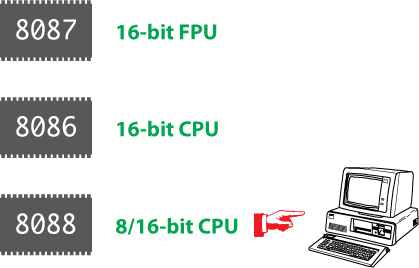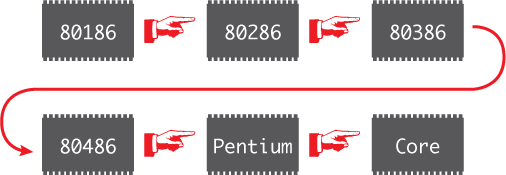Inside your PC’s bosom glows hot a fast electrical machine. Its billions of wires, transistors, and relays produce the fun, gooey nonsense you see on the screen. You should take it all for granted. I’m not joking: The processor is only a small piece of the PC puzzle, but one that has a notable history that I shall now bore you with the details.
The PC processor’s first ancestor was the original Intel microprocessor, the 4004 introduced in 1971. It wasn’t named after a famous number or even an interesting number: 4004 is the quantity of transistors on the chip.
The second generation chip doubled the number of processors, so it was called the 8008. Its descendant was the 8080, which was really a new type of chip, hence the different naming style. The historical progression is shown in Figure 1.

Figure 1. Intel CPUs from the early 1970s.
The 8080 was an 8-bit CPU (Central Processing Unit) and the next step on the PC power scale was 16-bits. So Intel introduced the 16-bit 8086 CPU in the late 1970s. The 8086 or “eighty eight-six” had a hybrid 8/16-bit cousin called the 8088. This microprocessor is notable as the CPU chosen for the first IBM PC, introduced in 1981, and illustrated in Figure 2.

Figure 2. Intel microprocessors available in the late 1970s. The 8088 was the chip used in the first IBM PC.
The 8086 featured a co-processor that handled math functions. This chip was known as the 8087 or math co-processor. It was also referred to as the FPU or floating-point unit. Eventually this chip’s technology was integrated with the CPU.
The 8086 began what today is known as the x86 architecture. Each succeeding CPU built upon the 8086, adding more features, becoming faster as illustrated in Figure 3.

Figure 3. The CPU lineage since the original IBM PC.
The 80186 chip wasn’t used in that many desktop computers. The non-IBM PC compatible Tandy 2000 used the chip, but nothing else that can I recall. The 80286 found its way into PCs, followed by the all-powerful 80386 chip, often called just “386.”
The 386 was a great CPU that introduced a lot of features, specifically the capability to run multiple virtual 8086 CPUs. It was this trick that allowed DOS and Windows multitasking back in the late 1980s thanks to programs like Desqview 386 and Windows/386.
The 80386 begat the 80486. At this time, people simply used the last three digits as the chip’s names: 386 and 486.
After the 80486, Intel changed its naming convention. What would have been the 80586 was known as the Pentium. It featured many variations, but most people referred to the CPU as “Pentium” no matter what the variety.
After the Pentium dawned the Core era, the current processor series. The Core CPUs use multi-core technology, where each chip contains multiple processor engines or cores. The popular models are the Core i3, Core i5, and Core i7, each more powerful than the other.
For the future, it looks like Core technology is here to stay. Intel keeps packing more power into the chips, but the names remain the same. In fact, a recent announcement was made the the next generation Core i7 will feature 10 cores, which is just an insane amount of processing power.


Intersting the main reason the ‘586 was called Pentium was you can’t copyright a numerical name such as 80486 where as you can with name like Pentium, they lost some control during the ‘486 era which led to 486SX, 486DX and the like.
Comment by glennp — June 10, 2016 @ 2:28 am
I’m glad that your brain is good enough to remember those bits. I had forgotten!
Comment by admin — June 10, 2016 @ 7:34 am